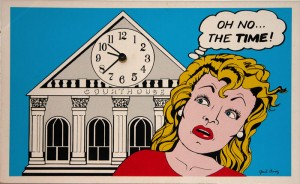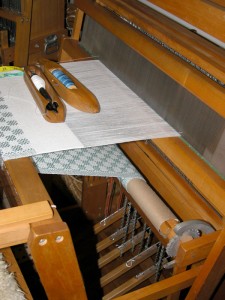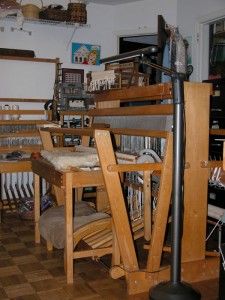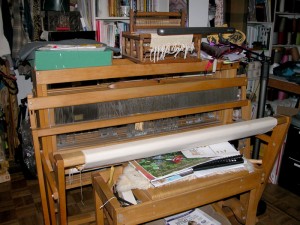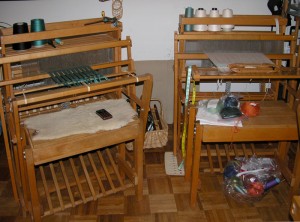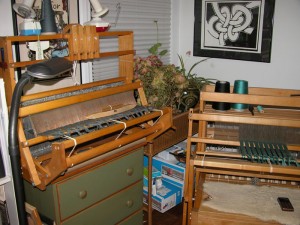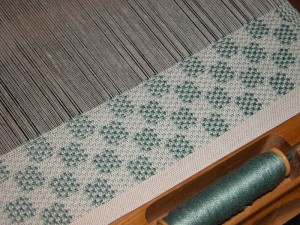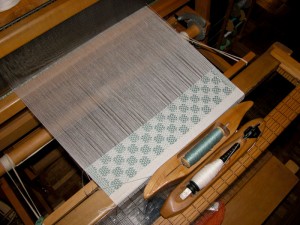I packed up a long list of supplies to bring to the American Sewing Guild neighborhood chapter meeting this morning. My local chapter is called the Clifton Clippers, which meets in, obviously, Clifton, NJ. It is a growing group, the few meetings I have attended, there are always a handful of new people.
Unlike my weaving guilds, the sewing guild programs tend to be more hands on, bring a machine and make a project. That’s really tough to do in the parameters of an average weaving guild meeting. So I’m not use to packing up supplies right before a meeting, and I enjoyed poking through my studio looking for stuff on the list.
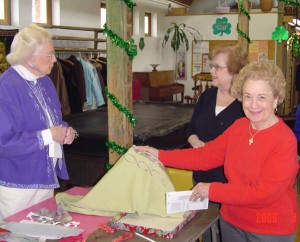 Today’s program featured ASG member Renie, a talented sewer quilter, who lead the group step by step in turning a sweatshirt into a decorative cardigan. That’s Renie in purple on the left. I didn’t shop ahead of time, and purchase a new sweatshirt for the occasion, I just rooted through my closet and picked the two that didn’t have anything written on the front. Works for me.
Today’s program featured ASG member Renie, a talented sewer quilter, who lead the group step by step in turning a sweatshirt into a decorative cardigan. That’s Renie in purple on the left. I didn’t shop ahead of time, and purchase a new sweatshirt for the occasion, I just rooted through my closet and picked the two that didn’t have anything written on the front. Works for me.
We were suppose to bring a half yard of coordinating fabric. In this group, it is assumed that your fabric will be a cotton quilt fabric, but I’m not a quilter, and my stash consists of a lot of odd things, and lots of handwoven scraps. I had a half yard piece of handwoven fabric, left from my production days, (that would be the 1980’s), poorly sett, plain weave, with lots of mixed warp yarns in various textures and colors, and a variegated rayon weft. I really wasn’t sure what we were going to be doing with it, but I packed up my machine and stuff on the list, and hit the road.
The meeting was fun. I love the companionship of others who think like me, are creative, I love show and tell, in any of my groups. One woman turned a daughter’s wedding gown into a Christening gown for her daughter’s baby. It was beautiful. What a great idea. And of course I showed off the dress I wore in the fashion show in California.
So the program started, and Renie carefully laid everything out step by step, she had a sweatshirt/cardigan on that was lovely, and had another one in various stages of development. She explained the process and then turned us loose. This guild is beginning to get use to me, only having handwoven fabric to play with.
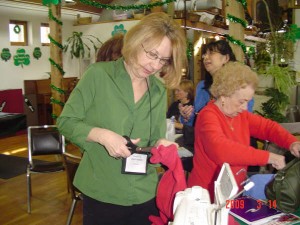
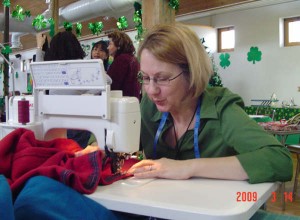 Well, I had a blast. Once I got the sweatshirt cut apart, and the bottom trim on, I packed up my things, to continue at home so I could use my own powerful iron, and I could concentrate. And take pictures…. 🙂
Well, I had a blast. Once I got the sweatshirt cut apart, and the bottom trim on, I packed up my things, to continue at home so I could use my own powerful iron, and I could concentrate. And take pictures…. 🙂
So, the first step was to remove the wrist bands and waist band. Then after carefully measuring, I cut up the center front, instantly transforming the sweatshirt into a cardigan. Renie showed a sweatshirt turned inside out, and I loved the feel of the inside of my favorite red sweatshirt, which I was cutting apart for this adventure, so I turned mine inside out as well. So the outside now feels like soft cotton fleece.
 Then I took my handwoven and cut 1 1/4″ strips off the selvedge, these I sewed to the bottom and fronts of the wrong side of the jacket, and brought them around to the front, top stitching the selvedge into place. Renie used quilt fabrics, which don’t have the same kind of selvedges as handwoven fabrics, so she left extra to turn under on her strips.
Then I took my handwoven and cut 1 1/4″ strips off the selvedge, these I sewed to the bottom and fronts of the wrong side of the jacket, and brought them around to the front, top stitching the selvedge into place. Renie used quilt fabrics, which don’t have the same kind of selvedges as handwoven fabrics, so she left extra to turn under on her strips.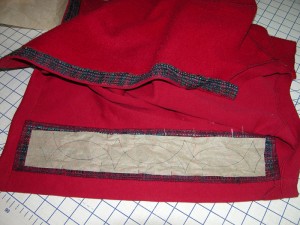
We were told to bring stencils if we had them, shows how much I know, I brought my fabric painting stencils, with fabric paint. Duh… what they really meant was quilting stencils. So I borrowed a pretty one from Renie, and traced the pattern onto the back of my materials list. I brought it home, and expanded it to fill the space on either side of the center front. I then finished off the edges of a wider strip of handwoven, and pinned it down on the back of one of the garment fronts, and then traced the quilting stencil pattern onto tissue paper. The old fashion kind that tears away easily. Renie could just draw the stencil onto the back of a quilt fabric, but that doesn’t work for a slubby multi-colored handwoven. I placed the tissue drawing down on the top of the handwoven strip, which was cut just a bit wider than the stencil design, and pinned everything into place.
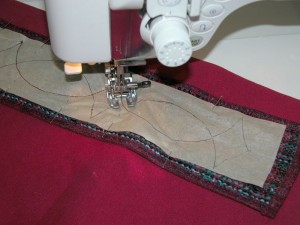 I went to my trusty Janome 6600, God I love this machine, and carefully followed the stitching outline I drew on the tracing paper with a medium size stitch length.
I went to my trusty Janome 6600, God I love this machine, and carefully followed the stitching outline I drew on the tracing paper with a medium size stitch length.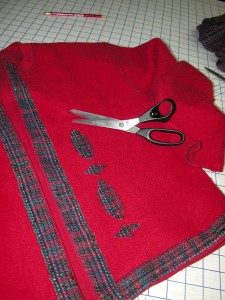
Once I finished the stitching, I tore away the tissue paper, and then from the right side of the jacket, I clipped away the sweatshirt fabric to reveal the handwoven underneath. Obviously you have to be careful here, and it helps to have sharp scissors with really blunt tips.
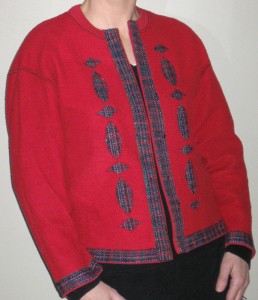 I worked on the second front, I was a woman possessed. Forget any thoughts of cleaning, or cutting out my poor arctic sky jacket lining. I wanted to finish this jacket. It is my new favorite thing to slouch around in. I’m calling it my studio sweater, for when I need something comfy to put around my shoulders while I’m working, my well worn sweatshirt is now a stylish jacket trimmed with handwoven. I finished edging the sleeves, and Voilá!
I worked on the second front, I was a woman possessed. Forget any thoughts of cleaning, or cutting out my poor arctic sky jacket lining. I wanted to finish this jacket. It is my new favorite thing to slouch around in. I’m calling it my studio sweater, for when I need something comfy to put around my shoulders while I’m working, my well worn sweatshirt is now a stylish jacket trimmed with handwoven. I finished edging the sleeves, and Voilá!
I realized that this is an excellent thing to do with a surplus handwoven scarf. The selvedges can be used for the edge trim, and the interior of the scarf can be the strip that peeks out of the cut away stencil design on the front. I have a few extra scarves sitting around, and I’m thinking there are other sweatshirts that could use a transformation…
Of course I worked right through dinner, and that meant we had to go out, so I got to wear my new jacket to the pizza place.
So now I’m going to totally blow off the rest of the evening, and watch the episode I missed last weekend while I was away, of Desperate Housewives, on my computer. Oh, and BTW, when I was exiting the subway Thursday night in NYC, I saw a poster on the wall advertising a new HBO series, starting on March 29, at 8pm, Alexander McCall Smith’s #1 Ladies Detective Agency Series. So those of you who don’t watch television often like me (Desperate Housewives is the only thing I watch other than Project Runway when it is airing), and don’t get advertising for this kind of stuff, you might want to tune in, the books are terrific!
